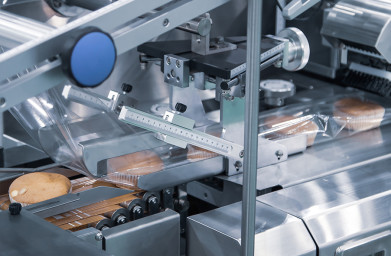
Shawcity, in partnership with Crowcon, provide specialist gas detection solutions for toxic, flammable and oxygen depletion hazards to protect workers and assets in the food and beverage industry.
The food and beverage can be divided into two major segments: production and distribution. Production includes processing meats and dairy products, or making soft drinks, alcoholic beverages, packaged foods and other modified foods.
Food production process can be divided further into three sub-groups. Firstly, food processing involves converting raw food into commodities, for example: milling wheat into flour and creating cheese from milk. The second sub-group is food processing that processes ingredients into edibles, for example creating bread from wheat. The third category is the commercial production of ready-to-eat foods, such as frozen pizzas – or any other ready-made meals.
Many food production processes involve fermentation, heating, chilling, dehydration or cooking, all of which create potential gas hazards. Cooking food, especially with steam boilers, is mostly heated by LPG or natural gas or a mixture of fuel oil and gas. Natural gas is largely made up of methane, which is a particularly flammable, lighter-than-air gas. LPG, on the other hand, mainly consists of propane, which is also highly combustible, but heavier than air. This requires onsite storage tanks, which in turn require forced mechanical ventilation in case of leaks. Naturally these processes need reliable and precise gas detection instrumentation.
Gas detection systems are a requirement for all gas-powered structures as well as underground basements and boiler rooms. The gas detection system will trigger alarms and actuators in cases of gas leaks, as well as turning off the gas and power supply, apart from to devices made for operation in explosive atmospheres, low voltage power or emergency lighting.
With stringent regulations, operators in the food and beverage industry must ensure that hygiene standards are met; the slightest contamination can create the perfect breeding ground for germs. Cleaning and disinfection, to comply with industry standards, is therefore a crucial aspect of food production. Chlorine based compounds are widely used for disinfecting equipment or food preparation surfaces – these compounds are highly effective, cost-effective and expeditious as disinfection, but they are also potentially hazardous and even exposure at parts per million levels can cause extremely adverse health problems. It is therefore crucial to deploy a gas detection system, with a relay system to activate ventilation fans or any other safety mechanisms once a significant level of chlorine has been detected.
Food packaging also has potential pitfalls. Nitrogen flushing methods are used for preserving and storing many products. Nitrogen is not toxic, odorous or reactive and is used to impede spillage whilst halting the growth of perilous bacteria and the oxidisation of fresh foods containing fats and/or sugars. Onsite generators or cylinders can provide the operators with nitrogen, but this gas is an asphyxiant which, when it displaces oxygen in air, can be extremely dangerous, especially as it is odourless and therefore impossible for personnel to detect without proper gas detection equipment. To protect workers in food packaging an oxygen depletion monitor will inform them if and when the levels of oxygen reaching dangerously low levels.
Refrigeration facilities are used to keep food consistently cool over long periods of time. Larger scale food storage facilities often utilise systems based on the use of anhydrous ammonia (> 50% NH3) because it is both effective and low-cost. Ammonia is toxic, flammable and lighter than air when no moisture is present but becomes heavier than air in moist environments and fills up enclosed spaces rapidly. Ammonia can combust in an enclosed space where there is a source of ignition, or when a vessel of anhydrous ammonia is exposed to fire. Ammonia is stored either as a gas or a compressed liquid, with no moisture present.
Ammonia is detected by using electro-chemical sensors for toxic gas and catalytic sensors for flammable gas monitoring. Portable and wearable detection devices, which includes single or multi-gas detectors, can monitor instantaneous and TWA exposure to toxic levels of ammonia.
Fixed detection systems combine toxic and flammable gas detectors connected to local control panels. These systems are usually provided with the cooling system. These systems can also be used to control process over-rides and ventilation control. Ammonia fills up breathing spaces quickly, so the detector placement should be carefully considered and carried out.
Situations that generate gas hazards within wineries and breweries include carbon dioxide emissions from fermentation, chilling, blanketing and recovery as well as disinfectants such as chlorine dioxide, ozone and sulphur dioxide widely used for cleaning equipment, argon and nitrogen used for blanketing gases to create inert atmospheres, ammonia from refrigeration equipment and oxygen levels in confined spaces.
Wine and beer often spend considerable time stored with distribution companies, warehousing and in the case of beer, draymen. Beer and soft drinks providers use carbon dioxide or a mixture of carbon dioxide and nitrogen to deliver a beverage to the ‘tap’ and to improve beer, its taste and to give it a longer-lasting head.
Gas-related hazards occur anywhere with compressed gas cylinders, this is caused by the risk of increased carbon dioxide levels or depleted oxygen levels caused by the presence of high levels of nitrogen.
Carbon dioxide is found naturally in the atmosphere, it is both colourless and odourless, heavier than air and therefore, if it leaks, it will generally sink to the floor. Carbon dioxide accumulates in cellars, at the bottom of containers and in confined spaces like tanks or silos. It is generated in large quantities during the fermentation process and added to beverages during carbonation.
Shawcity’s bespoke gas detection systems for the food and beverage sector can be designed, installed, commissioned, signed off and handed over by their in-house team. Output from the controllers will warn a central control room or building management system (BMS), either from an entirely new system or integrated into an existing set-up.





















